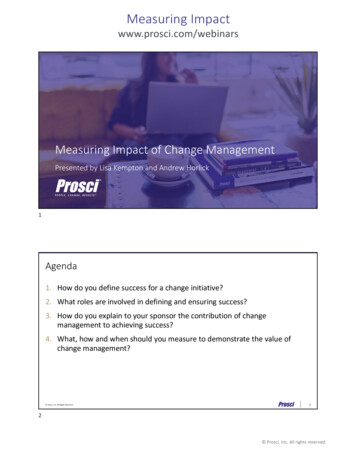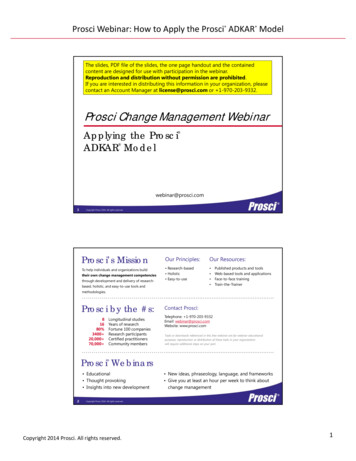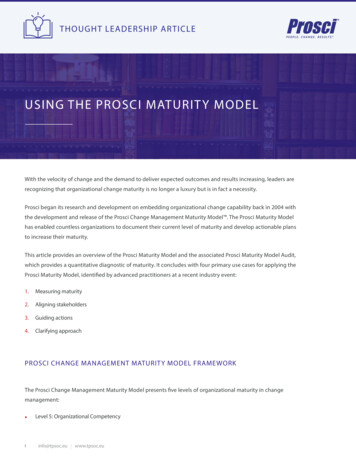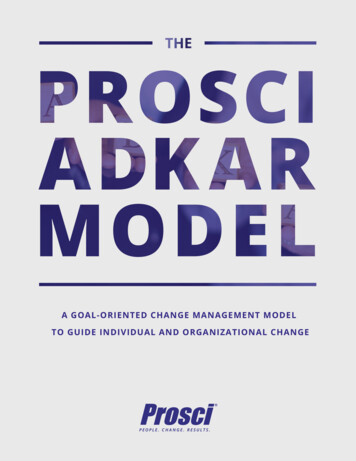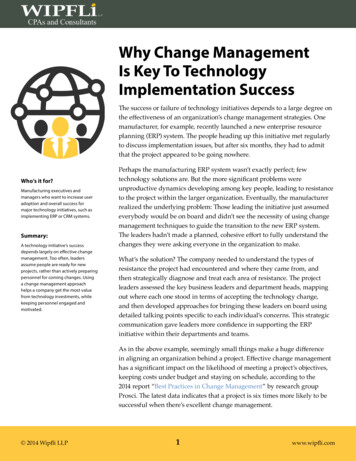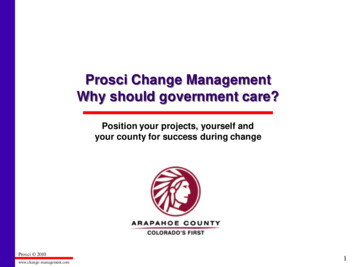
Transcription
Prosci Change ManagementWhy should government care?Position your projects, yourself andyour county for success during changeProsci 2010www.change-management.com1
“The dogmas of the quiet past are inadequateto the stormy present. The occasion is piledhigh with difficulty, and we must rise -- withthe occasion.As our case is new, so we must think anew,and act anew.”- Abraham LincolnProsci 2010www.change-management.com2
Are the changes we have underwayin our organization leaving our people behind?Prosci 2010www.change-management.com3
Prosci 2010www.change-management.com4
Prosci 2010www.change-management.com5
Organizations are reaching change saturationCurrent levels of change saturationMy organization is pastthe change saturation pointMy organization is at thepoint of change saturationMy organization is nearing thepoint of change saturationMy organization has somespare capacity for changeMy organization has quite a bitof spare capacity for changeMy organization has plenty ofspare capacity for change20092007Do not know0%5%10%15%20%25%30%Percent of respondentsProsci 2010www.change-management.com Prosci. From Prosci’s 2009 Best Practices in Change Management benchmarking report6
Agenda for Today Defining change managementIndividual change managementOrganizational change managementWho is involved in managing changeChange management vs. projectmanagement – what is the difference? Arapahoe County’s change managementprogramProsci 2010www.change-management.com7
Change ExerciseProsci 2010www.change-management.com8
Change management is:The process, tools and techniquesto manage the people side of change toachieve the required business results.Prosci 2010www.change-management.com9
But what is it really?Prosci 2010www.change-management.com10
Why is change so hard? In 1995, research conducted by John Kottershowed only 30 percent of all changeinitiatives were successful. Fast forward to 2008 that same surveyshowed only 30 percent of all changeinitiatives were successful.Prosci 2010www.change-management.com11
TMProsci PCT Model Leadership / Sponsorshipprovides guidance andgovernance Project Management givesstructure to the technical sideof the change Change Managementsupports the people side ofthe changeProsci PCT ModelTMAll three elements must be present for project successProsci 2010www.change-management.comThe Prosci Project Change Triangle (PCT) is a trademark of Prosci, Inc. All rights reserved.12
Organizational change can berepresented as three states of changeStates of changeCurrentstateHow things aredone todayProsci 2010www.change-management.comTransitionstateHow to move fromcurrent to futureFuturestateHow things will bedone tomorrow13
Examples of changes organizations arecurrently taking onCurrentstateTransitionstateFuturestateAd hoc processesDocumented and managed processesMultiple, legacy systemsOne integrated databaseGeneralists in the call centerSpecialists in the call centerNo web interface for suppliersSupplier website integrated into supply chainTwo different companiesMerged organizationProsci 2010www.change-management.com14
In reality, there are both organizationaland individual future statesOrganizationCurrentstateTransitionstateHow I will do my job after thechange is implementedHow I do myjob todayIndividualProsci teTransitionstateFuturestate15
The organization’s future state is actually thecollection of many individual future onstateFuturestateDocumented and managed processesOne integrated databaseSpecialists in the call centerSupplier website integrated into supply chainMerged organizationProsci 2010www.change-management.com16
The focus of change management is helpingindividuals make their transitionIndividualsChange management drives projectsuccess by supporting individualtransitions required by organizationalprojects and initiativesProsci stateCurrentstateTransitionstateFuturestate17
Why Change Management? Results and outcomes depend uponindividual change Data shows direct correlation to projectsmeeting objectives, schedule and budget Project and organizations take on costs andrisk when change is not managedeffectivelyProsci 2010www.change-management.com18
Change management is required to meetproject objectivesCorrelation of change management effectiveness tomeeting project objectives100%Percent of respondents that metor exceeded project %Poor(n 177)Fair(n 441)Good(n 561)Excellent(n 107)Overall effectiveness of change management program*Data from 2007, 2009 and 2011Prosci 2010www.change-management.com Prosci. From Prosci’s 2012 Best Practices in Change Management benchmarking report19
Connecting change managementto business resultsCorrelation of change management effectivenessto staying on schedule100%Percent of respondents that wereon or ahead of oor(n 134)Fair(n 318)Good(n 394)Excellent(n 72)Overall effectiveness of change management program Prosci. From Prosci’s 2009 Best Practices in Change Management benchmarking reportProsci 2010www.change-management.com* The 2009 report includes data from the 2007 and 2009 study.20
Connecting change managementto business resultsCorrelation of change management effectivenessto staying on budget100%Percent of respondents thatwere on or under r(n 116)Fair(n 299)Good(n 386)Excellent(n 71)Overall effectiveness of change management program Prosci. From Prosci’s 2009 Best Practices in Change Management benchmarking reportProsci 2010www.change-management.com* The 2009 report includes data from the 2007 and 2009 study.21
There are consequences of not managingthe people side of change Lower productivityPassive resistanceActive resistanceTurnover of valued employeesDisinterest in the current or future stateArguing about the need for changeMore people taking sick days or not showing upChanges not fully implementedPeople finding work-aroundsPeople revert to the old way of doing thingsThe change being totally scrappedDivides are created between ‘us’ and ‘them’Prosci 2010www.change-management.com22
Primary reasons for applying changemanagement Increase probability of project success Manage employee resistance to change Build change competency in the organizationProsci 2010www.change-management.com23
Change management perspectives Individualperspective– Understanding howone person makes achange successfullyProsci 2010www.change-management.com Organizationalperspective– The tools that projectteams and managershave to support the‘people side’ of change24
Equip your managers andsupervisors to lead changeIntroduce changes tohow the businessoperatesMeet the needsof their employeesRun the day-to-dayoperation and achievebusiness resultsProsci 2010www.change-management.com25
Why are managers so important? Supervisors/managers are influentialEmployees trust themThey are in a position to mitigate resistanceThey can build supportThey are a preferred sender!Prosci 2010www.change-management.com26
Equip your managers andsupervisors to lead changeProvide tools formanaging individualchange:The ADKAR Model Prosci dgeAbilityReinforcementSet expectationsof roles: CommunicatorAdvocateCoachLiaisonResistance manager27
Managing individual changewith ADKAR Prosci ADKAR Model AwarenessDesireKnowledgeAbilityReinforcement ADKAR describes thekey building blocks forsuccessful change– Personal or professional Success with changerequires all elements ofthe ADKAR Model to bepresent 2012 Prosci and Bill CiglianoReference: Hiatt, J. ADKAR: A model for change in business, government and our community, Learning Center Publications, 2006.ADKAR is a registered trademark of Prosci. All Rights Reserved.Prosci 2010ADKAR and “Awareness Desire Knowledge Ability Reinforcement” are a registered trademarks of Prosci, Inc. All rights reserved.www.change-management.com28
The five building blocks ofsuccessful changeProsci ADKAR Model AwarenessAwareness of the need for changeDesireDesire to participate and support the changeKnowledgeKnowledge on how to changeAbilityAbility to implement required skills and behaviors 2012 Prosci and Bill CiglianoReinforcementProsci 2010 Reinforcement to sustain the changeADKAR and “Awareness Desire Knowledge Ability Reinforcement” are a registered trademarks of Prosci, Inc. All rights reserved.www.change-management.com29
ADKAR forms the foundation of successfulorganizational change Ultimately, for a project or initiative to be successful,individuals in the organization have to do their jobsdifferently ADKAR provides a framework for understanding howindividuals change Managers and project teams can use ADKAR to:– Guide organizational change management plans– Diagnose gaps and root causes of resistance– Develop corrective actionsProsci 2010www.change-management.com30
Prosci 3-Phase ChangeManagement ProcessProsci’s organizationalchange management process A structured process for managingthe ‘people side’ of change on aproject or o-applyScalableProsci 2010www.change-management.com31
Phase 1 – Preparing for change Understanding thenature of the change Understanding thegroups being changed Creating the rightsponsorship model andcoalition Identifying risks Developing specialtacticsProsci 2010www.change-management.com32
Phase 2 – Managing change Prosci 2010www.change-management.comCommunication planSponsor roadmapTraining planCoaching planResistance mgmt plan33
Phase 3 – Reinforcing change Compliance audit reportsand employee feedback Corrective action plans After action review Transition managementProsci 2010www.change-management.com34
Connecting individual and organizationalchange managementChangemanagementtoolsIndividual phasesof change(ADKAR )CommunicationsAwarenessSponsor roadmapDesireCoachingKnowledgeResistance managementAbilityTrainingReinforcement Prosci 2010www.change-management.com35
Who is involved in managing changeSenior leadersProject team The change managementresource on a project playsthe role of enabler– The conductor of theorchestra– The director of the playChangemanagementManagers andsupervisorsProsci 2010www.change-management.com Effective changemanagement requiresinvolvement and action bymany in the organizationEmployees36
Senior Leaders Senior leaders– Active and visible sponsorship is identified as thetop contributor to overall project success inProsci’s five benchmarking studies– Senior leaders are one of two preferred senders ofmessages about changeProject team ChangemanagementManagers andsupervisorsProsci 2010www.change-management.comEmployeesWhy is this group important?What is this group’s role?– Participate actively and visibly throughout theproject– Build the needed coalition of sponsorship withpeers and other managers– Communicate the business messages about thechange effectively with employees37
Managers and Supervisors Senior leaders– Managers and supervisors are the other preferredsender of messages about change– This group has a unique and well-developedrelationship with the employees being impactedby the changeProject team ChangemanagementManagers andsupervisorsProsci 2010www.change-management.comEmployeesWhy is this group important?What is this group’s role?– Communicate the personal messages about thechange with their direct reports– Conduct group and individual coaching sessions– Identify, analyze and manage resistance– Provide feedback to the rest of the changemanagement ‘gears’38
Employees Senior leaders– Employees will ultimately make changes to howthey do their day-to-day work– Their acceptance and use of the solutiondetermines the success of the project and theongoing benefit derived from the change–Project team ChangemanagementManagers andsupervisorsProsci 2010www.change-management.comEmployeesWhy is this group important?What is this group’s role?– Seek out information related to the businessreasons for change and the personal impact ofthe change– Provide feedback and reaction to the change andthe change management efforts– Take control of the personal transition (using anindividual change management model likeADKAR)39
Project Team Senior leaders– The project team designs and develops the‘change’ – they are the ones who introduce newprocesses, systems, tools, job roles andresponsibilities– This group provides much of the specificinformation about the change to the other ‘gears’Project teamChangemanagementManagers andsupervisorsProsci 2010www.change-management.com EmployeesWhy is this group important?What is this group’s role?– Provide timely, accurate and succinctinformation about the change (or project)– Integrate change management activities intoproject management plans and activities40
Change management andproject managementProject ange managementProsci 2010www.change-management.comTechnical sideof the projectPeople side ofthe project41
Change management is likeproject management However, it is the ‘people side’ of change Both aim to deliver value to the business bysupporting initiatives and projectsProsci 2010www.change-management.com42
Comparing processes Project management––––– InitiationPlanningExecutingMonitoring and controllingClosingProcess groups defined in the ProjectManagement Institute’s PMBOK Prosci 2010www.change-management.com Change management– Organizational: Preparing for change Managing change Reinforcing changeTM– Individual: AwarenessDesireKnowledgeAbilityReinforcement 43
Comparing tools Project management––––––––Statement of workProject charterBusiness caseWork breakdown structureBudget estimationsResource allocationScheduleTrackingProsci 2010www.change-management.com Change management––––––––Individual change modelReadiness assessmentCommunication plansSponsorship roadmapsCoaching plansTraining plansResistance managementReinforcement44
The right amount How much projectmanagement is needed?– Depends on the complexityand degree of change toprocesses, systems,organization structure andjob rolesProsci 2010www.change-management.com How much changemanagement is needed?– Depends on the amount ofdisruption created inindividual employees’ dayto-day work and theorganization attributes likeculture, value system andhistory with past changes45
Integrating change management andproject management activities Project management and change managementactivities are most effective when they areintegrated Unfortunately, in many instances changemanagement is an add-on after the project hasexperienced obstaclesProsci 2010www.change-management.com46
Problem nDevelopmentImplementationProsci 2010www.change-management.com47
AssessmentsTeam aching andfeedbackResistancemanagementProsci 2010www.change-management.com48
BusinessimprovementstepsProsci ss49
sci 2010www.change-management.com50
Research resultsWhen to start change managementp. 29Project initiationProject planningProject designProject implementationWhen did you start CMactivities this time?When would you start CMactivities next time?Project closure0%10% 20% 30% 40% 50% 60% 70% 80% 90%Percent of respondents Prosci. From Prosci’s 2009 Best Practices in Change Management benchmarking reportProsci 2010www.change-management.com51
Case for Change Management In order to implement change individualsare going to have to do their jobs in a newway. What amount of project benefits dependupon employee adoption and usage?Prosci 2010www.change-management.com52
What is the adoption, usage andproficiency for your change? Who has to adopt and use the change? What does adoption and usage mean? How will we know if they have adopted andare using?Prosci 2010www.change-management.com53
The cost of NOT doingChange ManagementREwork, REvisit, REdo, REdesign, REscope,REschedule, REvamp, REquip, REenter,Reexamine, REcoverProsci 2010www.change-management.com54
Remember the Big Picture:The amount of Project Benefits aredependent on adoption and usage.This is what we can CAPTURE andDRIVE with change management.Prosci 2010www.change-management.com55
Prosci Measurement MatrixMeasuring Change Management Effectiveness Prosci d ofadoptionUtilization formanceagainstobjectivesIndividualperformancefor each jobrole56
Prosci Measurement MatrixMeasuring Change Management Effectiveness OutcomeProcessOrganizationProsci 2010www.change-management.comSpeed of adoption (ADKAR)Utilization rate (ADKAR)Proficiency (ADKAR)IndividualADKARMeasured by group, function,locationAssessment by immediatesupervisors as part of their rolein leading change(measurement using web-basedADKAR assessments)(measurement using ADKARinstruments)Business performance againstobjectivesFinancial performanceQuality of productQuality of serviceQuality of work lifeSpeed of implementation(schedule adherence)Individual performance foreach job rolePerformance against objectivesas defined in personal objectiveswith immediate supervisor57
Applying Change Managementto our Payroll/HRIS Project Started the Payroll/HRIS project without changemanagement We began applying it in May/June.– Increased communication/electronic and print– Increased face-to-face meetings and training– Mailing communication pieces home– Created prhrfeedback@arapahoegov.com– Solicited input – E-team, A-team, employees Here is the reaction Prosci 2010www.change-management.com58
Payroll/HRIS Comments “Thank you for the excellent communication you’ve been providing regarding thepayroll changes. You started the communication early in the process which allowsemployees ample time to prepare. I also appreciate the excel tool you designed to helpwith the transition, as well as the offers to assist with navigating through the change. Ireally appreciate all the efforts that have been made to make this transition as smooth aspossible!” - Lori Oswald, Human Services “I like the way this was written. Very clear and simple language,” – Debbie Atkinson,Information Technology “Excellent Write Up! Thanks!” – Grant Miller, Human Services “I wanted to let you all know how impressed I am with how this change is beingmanaged. The efforts, communications, training sessions and overall coordinationexhibited and offered to ensure our success with this major shift is amazing. I’m proudto be part of an organization who treats its employees with this level of considerationand respect. Thank you.” – Eve Torney, Information TechnologyProsci 2010www.change-management.com59
Arapahoe County’sChange Management Program Program Offerings:– Employee-Only Course– Coaching Course– 3-Day Practitioner Course– Sponsorship Course Nearly 300 Employees since February 2013 BOCC Administration, Communication Services, Human Resources,Human Services, Information Technology, Facilities and FleetManagement, Finance, Community Resources, Open Spaces, Clerkand Recorder’s Office, Sheriff’s Office, Public Works andDevelopment and Performance ManagementProsci 2010www.change-management.com60
Employee Program Goals Prepare employees for changes that are impacting thempersonally. Team them how to engage their manager and leadershipteam. Demonstrate effective ways to surface concerns about thechange Help them understand the change process Provide knowledge of how to take control of the change(and take accountability for their success)Prosci 2010www.change-management.com61
Coaching Program Goals Managers, supervisors and project leaders learnwhat it takes to become great change leaders. Prepare managers for changes that are impactingthem personally Prepare managers to lead and coach theiremployees through changeProsci 2010www.change-management.com62
3-Day Certification Program Learn how to lead change effectively, and what it means tomanage the people side of change. Participants learn how to define a change managementstrategy, prepare a change management plan and connectchange management to business results. Participants spend time working on a real-life project andwalk away with the knowledge, tools and processes tosuccessfully guide employees through change.Prosci 2010www.change-management.com63
Our Change Management Vision“We should work to build change managementcompetencies and capabilities because we careabout our employees.But, ultimately it’s about the customers we serve –the citizens of Arapahoe County.We owe it to them to provide the BEST Countygovernment in the State of Colorado.”Prosci 2010www.change-management.com64
How will we knowwhen we get there? Great change management is second nature andpart of the DNA of Arapahoe County Change Management is our standard operatingprocedure Change Management is the norm on projects andinitiatives All employees have internalized their role inleading changeProsci 2010www.change-management.com65
Position Arapahoe County for successLevel 5OrganizationalCompetencyChange management competency isevident in all levels of the organization andis part of the organization’s intellectualproperty and competitive edgeContinuousprocessimprovement inplaceLevel 4OrganizationalStandardsOrganization-wide standards and methodsare broadly deployed for managing andleading changeSelection ofcommon approachLevel 3MultipleProjectsComprehensive approach for managingchange is being applied in multiple projectsExamples of bestpractices evidentLevel 2IsolatedProjectsSome elements of change managementare being applied in isolated projectsMany differenttactics usedinconsistentlyLevel 1Adhoc orAbsentLittle or no change management appliedPeople-dependentwithout any formalpractices or plansProsci 2010www.change-management.comProsci Change Management Maturity ModelHighestprofitability andresponsivenessHighest rate ofproject failure,turnover andproductivity loss66
“If you want to make enemies,try to change something.”- Woodrow WilsonProsci 2010www.change-management.com67
“I am all for progress.I just don't like change.”- Jack BushProsci 2010www.change-management.com68
“It’s not so much that we’re afraid ofchange or so in love with the old ways, butit’s like that place in between that we fear It’s like being between trapezes.It’s Linus when his blanket is in the dryer.There’s nothing to hold on to.”– Marilyn FergusonProsci 2010www.change-management.com69
Change Management Focuses on the ‘people side’ of organizational change Involves both an individual and an organizational perspective Requires action and involvement by leaders and managersthroughout the organization And project management are both tools that support projectbenefit realization – project management is the ‘technical’ sideand change management is the ‘people’ side Is most effective when it is launched at the beginning of aproject and integrated into the project activitiesProsci 2010www.change-management.com70
Prosci 2010www.change-management.com71
What sound do you want to hear whenyour project is completed?Prosci 2010www.change-management.com72
Prosci1367 South Garfield AveLoveland, Colorado, USA 80537970-203-9332www.change-management.comAndrea RasizerDirectorBOCC Administration/Communication ServicesProsci Certified Change Management ProfessionalTrain the Trainerarasizer@arapahoegov.com303-795-4284Prosci 2010www.change-management.com73
From Prosci's 2009 Best Practices in Change Management benchmarking report Correlation of change management effectiveness to staying on schedule 16% 32% 60% 71% 0% 10% 20% 30% 40% 50% 60% 70% 80% 90% 100% Poor (n 134) Fair (n 318) Good (n 394) Excellent (n 72) Overall effectiveness of change management program
